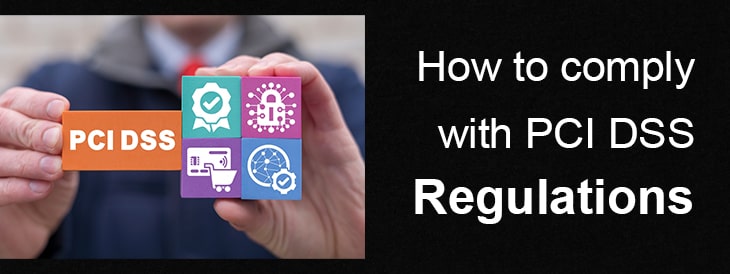How to comply with PCI DSS regulations
How to comply with PCI DSS regulations

Introduction to the PCI DSS
In today’s digital age, protecting cardholder data is vital for businesses involved in credit card transactions. The Payment Card Industry Data Security Standard (PCI DSS) provides a detailed framework that businesses must adhere to in order to safeguard sensitive cardholder information. This standard applies to all entities that accept, process, store, or transmit credit card data, making PCI DSS compliance crucial for businesses of all sizes.
PCI DSS was developed by major credit card companies to reduce credit card fraud and improve the security of card transactions. By following these guidelines, businesses can mitigate the risks associated with data breaches and unauthorized access to cardholder data. Non-compliance can lead to severe financial penalties and damage to a business’s reputation, making it essential for businesses to understand and implement PCI DSS requirements.
The standard consists of six main objectives that include building and maintaining a secure network, protecting cardholder data, managing vulnerabilities, implementing strong access control measures, monitoring and testing networks, and maintaining an information security policy. Each of these objectives encompasses various specific requirements that businesses must meet to achieve compliance. As threats to data security continue to evolve, adhering to PCI DSS helps businesses stay ahead in protecting sensitive cardholder information.
Some Related Blogs
- The Benefits of Using a Payment Processor That Specializes in High-Risk Businesses
- How to Integrate a Payment Gateway Into Your Website or App
- How to Get Approved for a High-Risk Merchant Account
- The Future of Payment Processing for High-Risk Businesses
Grasping the Requirements of PCI DSS
The PCI DSS outlines essential security standards to ensure that businesses handling credit card information maintain a secure environment. This comprehensive framework includes 12 primary requirements:
- Installing and maintaining a firewall to protect cardholder data.
- Avoiding the use of vendor-supplied defaults for system passwords and other security settings.
- Safeguarding stored cardholder data.
- Encrypting cardholder data during transmission across open, public networks.
- Utilizing and regularly updating anti-virus software.
- Developing and maintaining secure systems and applications.
- Limiting access to cardholder data based on business needs.
- Assigning unique IDs to individuals with computer access.
- Restricting physical access to cardholder data.
- Tracking and monitoring all access to network resources and cardholder data.
- Regularly testing security systems and processes.
- Establishing an information security policy for employees and contractors.
These requirements create a robust defense against unauthorized access, helping to mitigate the risk of data breaches and fraud. Each requirement focuses on different aspects of security, from technical measures like encryption and firewalls to procedural elements like monitoring and policy-making. Understanding and implementing these requirements are fundamental for businesses aiming to protect sensitive cardholder data effectively.
Steps to Ensure Compliance with PCI DSS
To achieve PCI DSS compliance, businesses should start by understanding the scope of their cardholder data environment. Identify where cardholder data is stored, processed, or transmitted. Conduct a gap analysis to determine where your practices fall short of PCI DSS requirements.
Next, implement robust security measures, such as installing firewalls and encrypting sensitive information. Ensure systems and networks are secure and up-to-date to prevent vulnerabilities. Employee training on data security best practices is critical to minimize the risk of human error.
Regularly updating software and systems is also vital to address vulnerabilities promptly. Establishing an incident response plan is another best practice. This plan outlines the steps to take if a data breach occurs, which can help reduce the impact on your business and customers.
Engage qualified security assessors who specialize in PCI DSS for additional guidance. They can help perform assessments and implement necessary changes. Lastly, invest in security training for all employees to ensure everyone understands their role in maintaining compliance.
By taking these steps, businesses can create a secure environment for handling cardholder data, meeting PCI DSS requirements, and protecting against data breaches and fraud.
Frequent Obstacles in Achieving PCI DSS Compliance
Achieving PCI DSS compliance presents several challenges for businesses. The intricate nature of the requirements can be daunting, especially for organizations that lack dedicated IT security resources. Managing and understanding the technical aspects, such as encryption, firewalls, and regular monitoring, requires specialized knowledge that not all businesses possess. Additionally, the constant evolution of cyber threats means that businesses must continually adapt their security measures to stay compliant.
Another significant hurdle is the resource investment needed. Compliance efforts require time, money, and skilled personnel, which can strain smaller businesses. Moreover, maintaining detailed documentation and audit trails can be a complex and time-consuming process, often necessitating advanced tools and systems.
Employee awareness and training are also critical factors. Human error remains a considerable risk in data security. Ensuring that all employees are well-trained and understand their responsibilities in safeguarding cardholder data is essential, yet often overlooked.
Furthermore, integrating PCI DSS requirements into existing business processes can be challenging. Many organizations struggle with aligning their operational practices with the stringent security measures mandated by PCI DSS, leading to potential gaps in compliance. Engaging with qualified security assessors can alleviate some of these issues, providing expertise and support in navigating the complexities of the standard. However, finding and working with reputable assessors can also be an obstacle in itself.
Overall, the journey to compliance is demanding and requires continuous effort and adaptation.
Sustaining Continuous Compliance
Maintaining PCI DSS compliance demands ongoing vigilance and proactive management. Regular reviews and updates to security measures help ensure that the business continues to meet the necessary standards. Quarterly scans and annual assessments are instrumental in pinpointing and mitigating vulnerabilities.
It’s also essential to stay abreast of any updates to the PCI DSS. Adjusting security practices to align with the latest guidelines keeps businesses prepared for evolving threats. Creating a culture of security awareness within the organization ensures that every employee is committed to protecting cardholder data.
Utilize tools and services designed to aid in continuous monitoring and compliance management. These can automate many aspects of compliance, making it easier to maintain a secure environment. Collaborating with qualified security professionals provides additional insights and expertise, further bolstering your efforts to protect sensitive information.
Regularly reviewing and updating security policies ensures they remain effective and relevant. This continuous cycle of assessment, adjustment, and education is crucial for sustaining compliance and safeguarding cardholder data against emerging threats.
![]()
Email us anytime!
Email customer service 24/7 at info@binarygateways.com
![]()
Call us anytime!
Reach customer care 24/7 at (801) 761-5001
